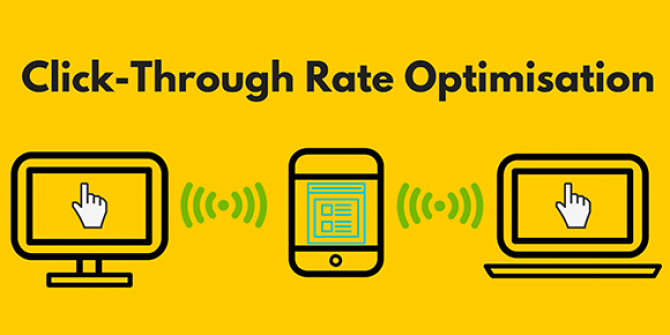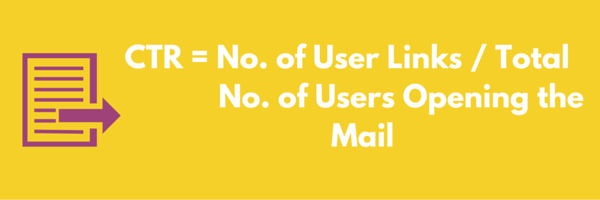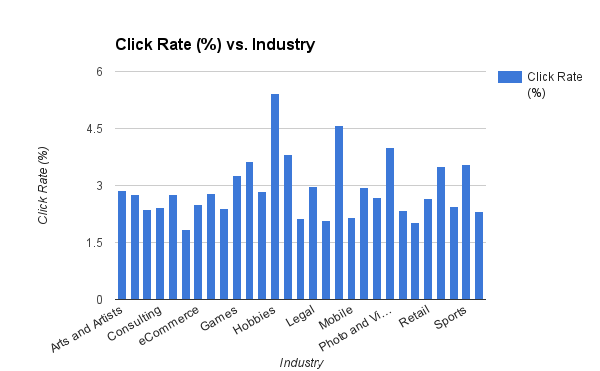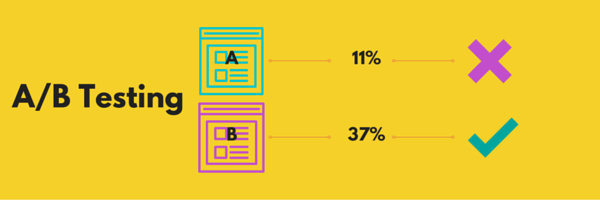
Email marketing is a vital tool for connecting with customers and keeping them constantly informed about products and developments. Customer engagement, however, is effective only if readers actually visit your website. That is where click-through rate (CTR) comes in.
What is Click-Through Rate?
Click-through rate (CTR) is highly useful in determining whether your email campaign is successful or not. Calculated as a formula, it depicts the number of users visiting your website via your marketing emails.

The higher your CTR value, the more customers are visiting your website. But, higher as compared to what? MailChimp did a research on email marketing metrics up to February 2016, according to which, click rates averaged at 2.80% across various industries. Generally speaking, click rates tend to be quite low, with the highest peak being approx. 5%

A study by Silverpop in 2015, on the other hand, found that transactional emails held an average CTR of 10.4% while that of non-transactional emails was 3.2%. Compared to other figures, transactional emails command a higher rate because users are more likely to open emails regarding their purchases and online transactions.
However, CTR isn't just about punching a few numbers into a formula. There are certain metrics that affect your click rates:
- Subject lines
- Calls to action
- Copy
- Images
- Placement of links
- Time of day
- Email length
- Sending consistency
Improving Your Click Rate
If you're click rate has been stagnant or dipping below the above-mentioned average, then perhaps it is time for some spring cleaning in your campaign. Or a complete revamp altogether.

- Your subject line is the first thing readers see. We have become accustomed to thinking that attention-grabbing lines that jump off the page will have readers clicking like crazy. So, why don't they? Customers receive a plethora of marketing emails on a daily basis and, as a result, have become adept at identifying ones that over-sell. When writing subject lines, stick to the point and tell what is inside. Advertising one thing and selling another will put your readers off to the point that they might unsubscribe from further mails. Also, keep in mind that too many exclamation points and all-caps always, always, spell disaster.


- Create a visual impact that appeals to the reader, and the key to that is in balancing. If the layout is too text-heavy then you have a snooze fest on your hands. If it is chock-full of images, they might not load and your customer has moved on without seeing what you have to offer. To combat disinterest, intersperse images with bold texts in bright colours and place them strategically to focus the eye towards the main points. Using ALT texts for images is also another handy tip if image viewing has been disabled.

- Using Button CTAs will get you a better response than text ones because they are easily identifiable and, well, because they look nice. Button CTAs direct the customers where to click without the need to hunt for it. In some cases, textual CTAs are unavoidable. MailChimp says that using 8-12 words in a CTA hits the “sweet spot” and results in an increase in CTR. As a compromise, place a button in a prominent position and strew texts in strategic spots.

- Your desktop layout should translate to mobile seamlessly what with a smartphone in every hand. Just because it is a smaller retail space does not mean you should compromise on design; quite the opposite, in fact. Even though click rates for desktops are higher than those of mobiles, many users browse their emails on smartphones and tablets. Design your layout in such a way that the important components – what the email is about and a relevant CTA – are visible at the top. If users like what they see and open it a second time on their computer, then there is a 65% chance of them clicking through.
Testing Your Implements

Testing the changes you've made to your email campaign is important before you start making the final call. An effective method is through an A/B test or a split test. A/B testing requires you to run the test on different variables, like your content, subject line, image placement, etc. It allows you to test how various changes affect your site visits via links.
Let's take MailChimp's in-built A/B testing tool as an example.

MailChimp provides you with four options of variables, viz. subject lines, from names, content, and send time. The tool creates up to three combinations, each implemented with a variation of your chosen variable, and sends it to recipients. The combinations are sent to all the subscribers if they are few. In the case of a larger list, sending campaigns to all the recipients is not feasible, hence, MailChimp allows you to segment your list into a certain percentage. Recipients from this segment are sent separate versions of the campaign at random. The winning combination is decided after a defined number of hours on the basis of either highest open rate, click rate, total revenue or a manually chosen metric. The “winning” combination is then sent to the remaining subscribers.
The benefit of A/B testing is that it provides you with an accurate measure of how successful your optimisation is. However, consumer preferences do not remain fixed for long periods of time; therefore, it is advisable that you administer changes to your campaign on a regular basis and run tests in tandem.
There are various tools and platforms that you can use to monitor the efficiency of your emails and their subsequent amendments. Some of the tools that support A/B testing are:
With the right alterations to your metrics, your email marketing campaign will kick-start with bigger and better conversions.













